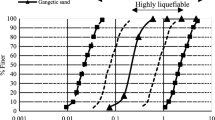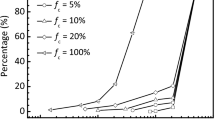Abstract
The relative density can be used as the main indicator to assess the liquefaction resistance of clean sands. As relative density of the sand deposit increases significantly following the initial liquefaction, one should expect that the soil can improve its liquefaction resistance. However, earthquake records indicate that densified sand can be liquefied again (re-liquefied) at smaller cycles by the similar seismic loadings. This work aims to clarify the counterintuitive finding that, after the first liquefaction, the resulting significant increase in relative density (induced by settlements and variation of the water level) do not necessarily imply an increase in the number of loading cycles for re-liquefaction. In this paper, we present a series of experimental results concerning the cyclic liquefaction and the following re-liquefaction of clean sand deposits. The experimental setup is performed by a shaking table, transmitting one-degree of freedom transversal motion to the soil within the 1.5 m high laminar shear box. At four different seismic demands, the input excitation was imposed three times to examine the influence of the initial distributions of the relative density and the consolidation characteristics on the liquefaction potential of the sand. The re-liquefaction cycles of the sand, which previously experienced liquefaction under the same seismic loadings, show that post-liquefaction reconsolidation of the sand deposits affects the re-liquefaction resistance.












Similar content being viewed by others
References
Castro G, Poulos SJ (1977) Factors affecting liquefaction and cyclic mobility. J Geotech Eng Div 103:501–516
Ecemis N (2013) Simulation of seismic liquefaction: 1-g model testing system and shaking table tests. Eur J Environ Civil Eng 17(10):899–919
Fiegel GL, Kutter BL (1994) Liquefaction mechanism for layered soils. J Geotech Eng 120(4):737–755
Finn WDL, Bransby L, Pickering DJ (1970) Effect of strain history on liquefaction of sand. J Soil Mech Found Div 96(SM6):1917–1934
Ha IS, Olson SM, Seo MW, Kim MM (2011) Evaluation of reliquefaction resistance using shaking table tests. Soil Dyn Earthq Eng 31:682–691
Ishihara K, Okada S (1978) Yielding of overconsolidated sand and liquefaction model under cyclic stress. Soils Found 18(1):57–72
Ishihara K, Okada S (1982) Effect of large preshearing on cyclic behavior of sand. Soils Found 22(3):109–125
Ishihara K, Yoshimine M (1996) Evaluation of settlements in sands following liquefaction during earthquakes. Soils Found 32(1):173–188
Jamiolkowski M, Ladd CC, Germaine JT, Lancellotta R (1985) New developments in field and laboratory testing of soils. In: Proceedings of the 11th international conference on soil mech and foundation engineering. Balkema Publisher, Rotterdam, pp 57–153
Koloski JW, Schwarz SD, Tubbs DW (1989) Geotechnical properties of geologic materials. Wash Div Geol Earth Resour Bull 78(1):1–2
Kulhawy FH, Mayne PW (1990) Manual on estimating soil properties for foundation design. Report EL-6800, Electric Power Research Institute, Palo Alto
Lee KL, Fitton JA (1969) Factors affecting the cyclic loading strength of soil. Vib Eff Earthq Soils Found ASTM STP 450:71–95
Lee KL, Albaisa A (1974) Earthquake-induced settlements in saturated sands. J Soil Mech Found Div 100(4):387–400
Mesri G, Feng TW, Benak JM (1990) Post-densification penetration resistance of clean sands. J Geotech Eng 116(GT7):1095–1115
Mitchell JK, Lee KM, Shen CK, Leung DHK (1999) Effects of placement method on geotechnical behavior of hydraulic fill sands. J Geotech Geoenviron Eng 125(10):832–846
Mulilis JP, Arulanandan K, Mitchell JK, Chan CK, Seed HB (1977) Effects of sample preparation on sand liquefaction. J Geotech Eng Div 103(2):91–108
Oda M, Kawamoto K, Fujimori H, Sato M (2001) Microstructural interpretation on reliquefaction of saturated granular soils under cyclic loading. J Geotech Geoenviron Eng 127(5):416–423
Ohara S, Yamamoto T, Yurino H (1992) Experimental study on reliquefaction potential of saturated and deposit. Paper presented at the tenth world earthquake engineering conference, Balkema, Rotterdam
Olson SM, Green RA, Obermeier SF (2005) Geotechnical analysis of paleoseismic shaking using liquefaction effects: a major updating. Eng Geol 76:235–61
Parkin AK, Lunne T (1982) Boundary effects in the laboratory calibration of a cone penetrometer for sand. In: Proceedings of the 2nd European symposium on penetration testing, vol 2. ESOPT-II, Amsterdam, pp 761–768
Phillips R, Valsangkar AJ (1987) An experimental investigation of factors affecting penetration resistance in granular soils in centrifuge modelling. Technical Report No CUED/D-Soils TR210, Cambridge University, UK
Poulos SJ, Hed A (1973) Density measurements in a hydraulic fill. Evaluation of relative density and its role in geotechnical projects involving cohesionless soils. ASTM STP 523:402–424
Renzi R, Corte JF, Bagge G, Gui M, Laue J (1994) Cone penetration tests in the centrifuge: experience of five laboratories. In: Proceedings of international conference centrifuge 94, Singapore, pp 77–82
Robertson PK, Campanella RG (1983) Interpretation of cone penetration tests, parts 1: sand. Can Geotech J 20(4):718–733
Robertson PK, Wride CE (1998) Evaluating cyclic liquefaction potential using the cone penetration test. Can Geotech J 35(3):442–459
Robertson PK (2009) Interpretation of cone penetration tests-a unified approach. Can Geotech J 46:1337–1355
Sanglerat G (1972) The penetrometer and soil exploration. Elsevier, Amsterdam
Seed HB, Idriss IM (1971) Simplified procedure for evaluating soil liquefaction potential. J Soil Mech Found Div 97(9):1249–1274
Schmertmann JH (1991) The mechanical aging of soils. J Geotech Eng 117:1288–1330
Suzuki T, Suzuki T (1988) Effects of density and fabric change on reliquefaction resistance of saturated sand. J Jpn Geotech Soc 28(2):187–195
Tatsuoka F, Ochi K, Fujii S, Okamoto M (1986) Cyclic undrained triaxial and torsional shear strength of sands for different sample preparation methods. Soils Found 6(3):23–41
Thevanayagam S, Kanagalingam T, Reinhorn A, Tharmendhira R, Dobry R, Pitman M, Abdoun T, Elgamal A, Zeghal M, Ecemis N, El Shamy U (2009) Laminar box system for 1-g physical modeling of liquefaction and lateral spreading. J ASTM Geotech Test 32(5):438–449
Tokimatsu K, Hosaka Y (1986) Effects of sample disturbance on dynamic properties of sand. Soils Found 26(1):53–64
Tokimatsu K, Seed HB (1987) Evaluation of settlements in sands due to earthquake shaking. J Geotech Eng 113(GT8):861–878
Whitman RV (1970) Hydraulic fills to support structural loads. J Soil Mech Found Div 96(SM1):23–47
Wong RT, Seed HB, Chan CK (1975) Cyclic loading liquefaction of gravelly soils. J Geotech Geoenviron Eng 101(6):561–583
Yasuda S, Tohno I (1988) Sites of reliquefaction caused by the 1983 Nihonkai-Chubu earthquake. Soils Found 28(2):61–72
Acknowledgments
This research was supported by the TUBITAK Project No: 111M435. These supports are gratefully acknowledged. The authors wish to thank Asst. Prof. Gursoy Turan and Asst. Prof. Selcuk Saatci, for their helps in conducting tests on the shaking table which exists at Izmir Institute of Technology (IZTECH) structural engineering laboratory.
Author information
Authors and Affiliations
Corresponding author
Rights and permissions
About this article
Cite this article
Ecemis, N., Demirci, H.E. & Karaman, M. Influence of consolidation properties on the cyclic re-liquefaction potential of sands. Bull Earthquake Eng 13, 1655–1673 (2015). https://doi.org/10.1007/s10518-014-9677-y
Received:
Accepted:
Published:
Issue Date:
DOI: https://doi.org/10.1007/s10518-014-9677-y




